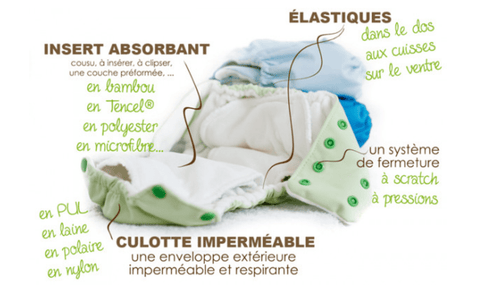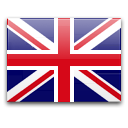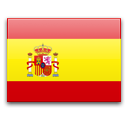The Cloth Diaper Guide - All About Washable Diapers
Tips for getting started with cloth diapers

What is a washable diaper?
Before going into the details, let's see how a washable diaper is made, we will then see the specifics (TE1, TE2, TE3, Insert, Poche, Booster etc ... )
The layer is made up of 3 parts:
- An absorbent part: This part can be made of different materials, it absorbs liquids and keeps the baby dry.
- Waterproof panties: Usually made of PUL, they keep liquids and solids inside the diaper.
- A closure system: to keep the layer waterproof, using elastic bands and snaps or scratching.

Now that we have the 3 large parts of the diaper we will differentiate several models depending on how the absorbent part fits into the washable diaper .
The different models of washable diapers
The TE1 or All in 1 washable diaper
The TE1 washable diaper is the simplest diaper on the market. The absorbent part is directly sewn into the waterproof part. So we put everything in the machine at each change.
Convenient because it doesn't require a lot of handling, it's a bit like having a disposable diaper that you wash every time.
The washable layer TE2 or All in 2 or even TE1 with pocket
The TE2 washable diaper is the most used diaper. Like the TE1, there is often an absorbent part sewn into the TE2 layer. However, this part constitutes a pocket in which you can add an additional absorbent insert which will increase the absorbency of the diaper.
Washable diapers are generally scalable in size (from 3kg to 15kg). Babies do not have the same needs when they grow up, so the absorbency of the cloth diaper can be adjusted as needed. It's also handy at night, to prevent leaks when less diaper changes.
The other advantage is that you don't have to change the diaper at each change and limit yourself to the insert.
The washable layer TE3 or All in 3
The TE3 washable diaper is the most flexible since the absorbent parts and the waterproof parts are completely separate. You therefore have an insert and a waterproof panty to assemble at each change. Even more true than for the TE2 the change of the waterproof part is not necessary for each change.
The parts to be inserted in the layer
Disposable veils
Not mandatory but which seems necessary to us, the disposable veils for washable diapers TE1 TE2 TE3 that we put last in the diaper allow all solid parts to be simply thrown away when changing. No need to scrape the insert or the bottom of the diaper, just put it in the trash.
A real “game changer” in the washable diaper routine.
Absorbent inserts
There are 4 main subjects for the es Absorbent Inserts for Washable Diapers :
- Organic cotton inserts
- Bamboo inserts
- Microfiber inserts
- The hemp inserts

In the photo of hemp inserts , known for their high absorption capacity
Organic cotton inserts:
From natural origin, drying time and absorption are average. It is the most used, but its manufacture is very expensive in water.
Bamboo inserts:
Bamboo inserts have very good absorption and very short drying time. It is also the most processed because it uses solvents to be processed into viscose.
Microfiber inserts:
The microfiber inserts , Despite an average absorption and a fast drying time, microfiber is the most recycled material. Be careful, however, it will have to be boosted quickly otherwise beware of leaks. It requires special attention to maintenance to avoid clogging.
The hemp inserts:
The hemp inserts are very absorbent but take a long time to dry. Hemp is the green material for inserts because it grows very easily. Black point odors can persist and become cardboard when washed if the water is very hard.
The sizes
Scalable diapers follow a child's growth from approximately 3kg to 15kg. You can adjust the size with several pressure levels.
Otherwise S / M / L / XL diaper sizes are available depending on your child's height and weight. They will need to be renewed when the child grows up. It is widely accepted that a child will need 2-3 sizes to get clean.
Do cloth diapers make you big butt?
It is true that cloth diapers are larger than disposable diapers. But you have to qualify, there can be big differences depending on the types of diapers and the inserts you are going to put inside.
The TE1 for example are thicker than the TE2 with a hemp insert which is very absorbent.
The smaller the baby, the heavier the diapers will look. If you have trouble closing the bodysuits you can purchase body extender or body extender < / a>. These are clipped onto the usual closure of the body and allow you to gain a few sizes on the bodysuits when they get a little tight.

White body extension for babies (from € 1.90 a piece)
Which washable diaper routine?
The Equipment
What equipment and what maintenance for your cloth diapers?
To switch to a 100% washable diaper with washing every 2 or 3 days, we recommend 20 to 25 TE2 diapers.
- 15 to 20 TE2 for the day
- 5 TE2 + 10 insert for the night
Vary the inserts by favoring large absorbers for the night (big butt effect!). For the day it depends on your child, for some the TE2 without insert will suffice, others will add a microfiber insert and for some it will take hemp each time.
Test some models before buying everything and do not hesitate to mix the solutions according to the situations (day, night, travel, vacation, nursery).
Buy new or used cloth diapers?
There are two main points to check when shopping for used diapers.
1- The rubber bands may have suffered and then it's the leak! Check the elastics carefully. If you are a handyman, you can change them to new ones.
2- Warning dirty layer. Maintaining diapers requires a bit of rigor, we'll talk about that below. If the diaper has been washed with Marseille soap, if it is gray or has stains, you will probably have to do several scrubbing baths (we will explain everything about scrubbing afterwards).
To find inexpensive cloth diapers, check out leboncoin, vinted or even facebook.
For those who wish, there are several facebook pages that connect parents with each other for the purchase of second-hand cloth diapers. This is a good way to get started inexpensively. You can also find plenty of advice and even help if you have any difficulties.
example: Cloth Diapers For All: Mutual Aid And Benevolence
https://www.facebook.com/groups/5970083084 < / span>
Sales-Trade-Purchase-Rental Cloth Diapers
https://www.facebook.com/groups/ 167270576805308
You can sell your diapers yourself when they are finished.
Before using your TE2 (or TE1 and TE3) cloth diapers for the first time
Washable diapers and new inserts can be soaked for a dozen hours in cold water before first use. You can also machine wash them 2 or 3 times, in fact the fiber gains in absorption over time and the absorption becomes maximum after about fifteen washes.
So don't worry the first few times if the diapers fill up quickly, the capacity will increase with the washings!
What to do before using second-hand cloth diapers for the first time?
Before first use, scrub the cloth diapers used
Do a disinfection (soaking in bleach then washing machine) < / span>
Wash again at 60 ° C
Washable diapers should be clean, white, unstained, and odorless (wet or dry).
Storing your washable diapers between 2 washes
To store diapers between machine washes you will need:
- A waterproof seal or bin with a cover that closes
- A waterproof bag sealed against liquids and odors (ideal for on the go)
The ideal is to put the dirty diapers in a washing bag that you will put in your waterproof trash. This will facilitate handling to put them in the machine.
We do not recommend storing your diapers in water, they will deteriorate faster and they will be more difficult to handle.
The element that seems necessary to us to use washable diapers is the disposable veil. Placed in the diaper between the insert and the baby, it collects the solids (stool). It allows you to throw them directly into the trash on the conlayer retention. If ever there are overflows, it is necessary with paper to wash the diaper as far as possible above the toilet for the solid parts then rinse it with cold water before storing it.
Washing machine cycles for cloth diapers
- Rinsing: You can rinse your diapers in the first part and then add regular laundry. The goal is to rinse the urine before washing.
- Washing temperature: 40 ° C is sufficient temperature for cleaning diapers. 60 ° c if the diapers are really very dirty or from time to time if there are odors.
- Products for washing diapers: see our dedicated chapter with the list of products recommended to prevent clogging.
- Drying: Air is your friend and the sun is your ally! The sun has a whitening effect. For TE2 or TE1 washable diapers, do not tumble dry. Only the inserts can be put in the dryer.
Budget
An average child will consume 6,500 diapers from birth to potty.
The total budget for disposable diapers will vary enormously depending on the brand you choose for diapers. On average the cost will be from 1200 € to 2500 € For disposable diapers. For washable diapers the estimated cost is around € 600.
The expenses incurred for disposable diapers are therefore twice as high as those for washable diapers.
It's not intuitive, especially when you start to look at the price of cloth diapers can be scary, but if you look closely at the overall cost over 3 years, you get there finds.
Beyond the budget to allocate to diapers, you have to understand that we will buy washable diapers at once and disposable diapers as and when. < / span>
If you want to equip yourself for 3-day washing cycles, you will need about twenty inserts and ten washable diapers. < / p>
This represents a minimum budget of 200 € to which must be added the special trash and a waterproof bag to store diapers as you go.
Let's count large 300 euros that we multiply by 2 to have another 3-day cycle and have time to wash and dry our equipment.
We find washable diapers at 600 € vs 1200 € for disposable diapers
Washable diapers represent a huge saving over 3 years, you just have to be aware of it to invest the necessary 600 euros from the start.
Another advantage is that we can sell our diapers when the child is clean.
The rental
An alternative to buying cloth diapers is renting. By typing on the internet “rental of cloth diapers” you will find several companies which have positioned themselves in this niche. The concept is interesting and can make it possible to test different types of TE1 TE2 or TE3 layers and to vary the colors. The advantage of renting is also the guarantee of having good equipment throughout the child's growth. Renting your diapers will also avoid having to advance the 600 euros we mentioned above.
Environmental benefits
Using reusable diapers is above all a responsible gesture towards the environment. Ecological because you consume less resources and generate less waste. It really is a very virtuous system for your child's environment and their planet of tomorrow.
It's great, but what are we actually saving?
Water:
Washable diapers 2416L & lt; 19833L disposable diapers
2416L is the water requirement to produce 24 washable diapers
19833L to make the 6,500 disposable diapers a child will need.
Of course, add the 83M3 of water needed to wash the cloth diapers. Or 83m3 against 120m3 for a disposable diaper.
Petroleum
Washable diapers 0kg & lt; 67kg disposable diapers
67kg of petroleum contained in disposable diapers
0kg of oil in the wash basins
What do disposable diapers really contain
the National Health Security Agency (ANSES) published a report on the composition of disposable baby diapers with a record once again very severe. Out of 23 references analyzed, all have exceeded the health thresholds for at least one chemical substance, even for the so-called "ecological" layers.
A clear statement that is cold in the back. We let you read the test of 60 million consumers:
https://www.60millions-mag.com/2018/09/01/test-de-couches-bebe-quand-l-absence-de- toxic-residues-12212
How to store soiled cloth diapers?

Example of waterproof bag for washable diapers . Retains odors and liquids
Maintenance of washable diapers
- Store used diapers in a dry basket
- Throw solid parts down the toilet
- Remove the pocket inserts and the disposable protective net
- Sort delicate items or items that might lint in another laundry net
- Use the prewash function of your machine OR rinse with fresh water (to dilute the urine contained in the diaper )
- Set the water temperature to 40 ° C (If this is not possible wash at 30 ° C )
- Rinse 2 or 3 times (until the diaper no longer smells of detergent, wring out then dry linen
What detergent for cloth diapers?
To wash your washable diapers without risk of soiling and without damaging them, they must not contain glycerin, fabric softener, bleach. Do not use stain remover and limit the quantity of product on each machine.
There are two solutions for "homemade" detergents:
- Detergents with Marseille soap (be careful, you need real Marseille soap)
- ivy detergent also works but some find it less effective
Homemade laundry detergent recipe for washable diapers
To make your own homemade organic laundry suitable for cloth diapers, you will need:
- 150g of Marseille soap
- 3 tablespoons of baking soda
- 3 tablespoons soda crystals
Material:
- A saucepan
- A large salad bowl
- A wooden spoon
- A funnel
- A large bottle (to put the 3L of product)

- Grate the 150g of Marseille soap into shavings (with a cheese grater or a knife)
- Add the shavings to 1.5L of hot water in the saucepan
- Mix with the wooden spoon to dissolve the chips without boiling
- Pour 1.5L of water at room temperature into the bowl
- Add the soda crystals and baking soda and mix
- Once diluted, pour the bowl into the saucepan
- Mix then pour your detergent into the (glass) bottle using the funnel
- Let stand 12 hours
It can happen that the detergent gets out of phase in the bottles, you just need to shake them to homogenize the mixture before using it.
It can also happen that your special diaper detergent becomes more and more pasty (hard), you can then add a little hot water and shake vigorously to rehydrate your laundry.
WARNING: if you want to wash clothes with this detergent, you will have to remove the soda crystals from the recipe otherwise your clothes will be visible. its whiten.
Otherwise, if you only use it for your child's cloth diapers, you can increase their effectiveness by adding two tablespoons of sodium percarbonate directly with the diapers in the machine. Your diapers will only be better disinfected and laundered.
List of accounting detergents for washing cloth diapers
Ecological detergents:
- Biocoop (liquid)
- Ecoegg
- P'tits Dessous
- Soapix
- Sonnett
- Stylish
- Ulrich
- Ecoclaire floral notes (La Vie Claire)
- Miocare Bambino Mio
- Tree frog Aloe Vera (not with Marseille soap)
- Potion
- Neutral
- The Artisan Soap Maker
Compatible non-organic detergents:
- Ecological Apta powder
- Ariel Actilift powder
- Ariel Actilift liquid
- Ariel Alpine powder
- Ariel Alpine liquid
- Ariel Color powder
- Ariel Color liquid
- Ariel Original powder
- Ariel Original liquid
- Ariel Professional powder
- Ariel Professional Color powder
- Ariel Porpre and fresh powder
- Ariel Clean and fresh liquid
- Auchan ecological
- Ava Vanish powder
- Ava Vanish liquid
- Bambinex
- Body Nature powder
- Delicate Nature Body
- Dash Plein air powder
- Liquid Lily Stamen for Baby
- Filetti sensitive powder
- Filetti sensitive liquid
- Formil Actif powder (not with Marseille soap)
- Freshness U powder
- Freshness U liquid
- Gama Professional, Professional powder formula
- The Baby Cat
- The Cat The powder expert
- Le Chat The liquid expert
- The Cat Expert Professional in baking soda
- Liquid Cat with essential oils
- Le Chat Sensitive powder
- Le Chat Sensitive liquid
- Leclerc Eco +
- Leclerc landmark
- Powder detergent, green fresh scent, Leader Price
- Carrefour liquid aloe vera detergent
- The green tree
- Mir Colors
- Omo Active powder
- Omo Active liquid
- Omo Wit powder
- Omo Wit liquid
- Parsley Power powder
- Parsley Power liquid
- Parsley Color powder
- Parsley Color liquid
- Parsley Universal powder
- Parsley Universal liquid
- Casino Powder
- Sanytol disinfectant detergent
- Skip Active Clean powder
- Skip Active Clean liquid
- Skip Color Clean liquid
- Skip Liquid intense freshness
- Skip Liquid hygiene
- Skip Sensitive liquid
- Skip Ultimate liquid
- Super Blue Cross
- Tandil powder
- Liquid tandil
- X-tra total powder
- X-tra total liquid
Detergents not recommended:
- Lavender liquid biocoop
- Carrefour Agir
- Dash 2/1
- Ecodoo (effectiveness discussed)
- Ecover
- Epsil powder (effectiveness discussed)
- Liquid Epsil (effectiveness discussed)
- Gamma
- Green harmony
- Lerutan
- Monoprix
- Piwapee
- Super Secret Cross from elsewhere
Where to buy cloth diapers
You can buy cloth diapers mainly on dedicated or general websites, in baby or organic food stores, and organic salons. Some childcare chains such as Aubert or Bébé cash are starting to reference washable diapers.
Buy Washable TE2 Diapers Cheap
Can we put washable diapers in a nursery
While nurseries and day care centers are increasingly aware of the value of cloth diapers, it will still take a little time to achieve 100%. That said, some nurseries have gotten used to it and it works well, the feedback shows that the teams find the system ultimately simpler than they thought. Like at home, a certain protocol and an organizational routine have to be put in place, but it works quite well.
If this is not the case with your nursery, you will have to see your childcare center directly, but why not initiate the change with them. By discussing it you will certainly plant a seed to initiate change!



